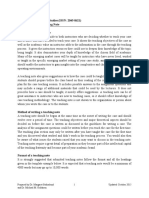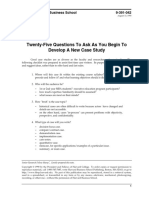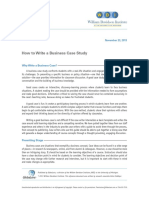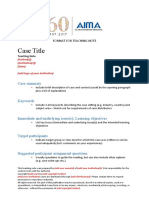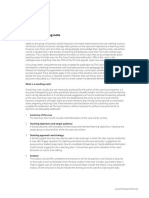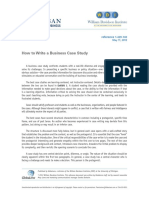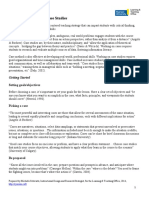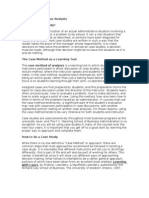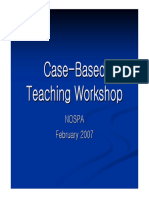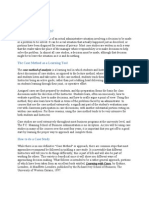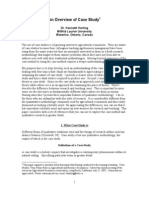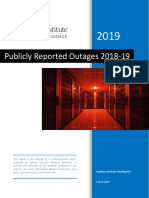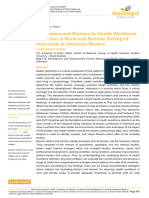Writing Cases
Melodena Stephens Balakrishnan
The difference from a case study research methodology and a teaching case study
Teaching cases differ from research cases primarily in terms of application. While
one is used as an instrument to facilitate teaching and add to practical knowledge
the other is a methodology used to support research findings, and add to the body of
theoretical knowledge. The style of writing differs. Teaching cases should be
interesting and have a story line that students can get immersed in and relate too
while Research cases are more evidence based and must relate to academic peers
(two different audiences). The other key difference is that teaching cases highlight
practical applications of theory and concept to real world situations, they are a
documentation of the same (they reflect the ambiguity of the situation) and need not
have a single outcome as the intent is to create a dialogue with students, encourage
critical thinking and research and evaluate recommendations. On the other hand
research cases are more academic and are focussed on a research outcome.
Like research cases, you should have a case study protocol (a list of questions) and
collect relevant information from your case organization or case lead. You should
ensure you not only have correct documentation, you must try to get permission
letters.
Balakrishnan (2010)
�Is it important to mention the person and the decision role?
Yes it is important to mention the person and the decision role. This is because this
information gives the student an idea of the role they must take. Decision problems
escalate with levels, responsibilities increase and so does the strategic time frame.
To make the right decision, a student must not only know the role they must play, but
the decision outcome expected, the resources available (money, manpower etc) and
the context. You can disguise the company and the role title but there must be
enough similarity with the situation so that the case can help the student understand
the complexities of each choice and the outcomes; both in achieving the stated
objectives and any other sub-objectives that may exist in the system.
Who Am I
What is my name and title? What is my role in the
Where am I based? organizational and
responsibilities?
What is my measureable
objective that I am trying Whom do I report to and
to take a decision on? who reports to me?
Why?
Are there any market constraints
that I am under pressure from
(global, industry stakeholders Are there any organizational
(competitors, distributors, suppliers constraints that I am under pressure
etc), customers, press/media)? from (deadline dates; past
performance, team dynamics)?
Balakrishnan (2010)
�What will make your case unique?
A unique case study chooses an industry, decision problem area, or a market where
little data exists and conventional theoretical norms do not always apply. The context
of a case is very important to the case as decisions are influenced by the pressures
of the variables at that time. By documenting the context, and relating it to the
teaching objective, the case allows the students to get a simulated feel of what was
going on, the constraints the decision maker was facing and the dynamics of the
pressures of the job. As a writer you may not be able to capture all these points but
you should be able to give a feel of what was going on. The important thing is don’t
drown your reader in facts especially if it takes away from the story. If needed put the
additional data in teaching resources so your very finicky reader (which student loves
to read long cases?) still has access to more data but can quickly get the gist of the
case.
Building up the Context
Describe the country of origin
Describe the industry of and focal market of operation
operation and especially
highlight the unique
quirks or issues that
make the market Describe the
challenging organization, its history,
its vision, is structure
(large, small, diversified,
SME, adaptable?) and its
culture.
Describe your focus product
and help the student
understand its potential and
its realistic performance in
the market place vis a vis What is the time-line for the
competitors. How is this objective? Why the urgency? What
product objective fit within could be the possible consequences
the organization objective for not achieving your objective?
Balakrishnan (2010)
�What is the starting point of a good case study?
Though intuitively I would say the teaching objective, realistically it is with a good
access to a story. When you find one interesting case, it is important to “bag” it by
getting permission. Since these cases need approval they sometimes start out one
way and end another. There is nothing wrong in that. The most important point is
collecting as accurate a picture of the setting of the story which is always the
backbone of the decision problem. Another important aspect to explore is whether
the teaching objectives may spillover to multiple disciplines. Do look at all angles as
this makes your cases more interesting and widens the reach.
Case Writing: Key Steps
5. Write the Teaching Notes and try
the case in class so see if there is
enough information
4. Write Case and get permission
to publish even if the case is
disguised
3. Collect Information
on case through
documents,
interviews
2. Identify
Case Lead
1. Teaching
Objective
Balakrishnan (2010)
�What is the format of writing a teaching case study?
Students all over the world hate to read especially as today time is short. So if the
objective is to grab their attention, encourage participation and actually stimulate
active thinking rather than a more passive approach - you should make your case
interesting and relatively short (2-6 pages). You may have an additional 3-4 pages of
resources in the teaching notes. This allows the teacher (who is NOT you and may
not have as much information about your case) to facilitate the class to a more
fruitful discussion and optimize the teaching objective.
Case Study Format
Title – should be interesting with an idea of what
Capturing Mind Share of Weight
Conscious: Company X, Syria the case is about, name of organization and
market
XXXXXXXXXXXXXXXXXXXXXXXXXXXXXXXXXX
XXXXXXXXXXXXXXXXXXXXXXXXXXXXXXXXXX
XXXXXXXXXXXXXXXXXXXXXXXXXXXXXXXXXX Introduction paragraph should talk about
XXXXXXXXXXXXXXXXXXXXXXXXXXXXXXXXXX the decision maker, the problem and time
Company X
frame and a brief 2 sentence background.
XXXXXXXXXXXXXXXXXXXXXXXXXXXXXXXXXX Not more that 10 sentences
XXXXXXXXXXXXXXXXXXXXXXXXXXXXXXXXXX
XXXXXXXXXXXXXXXXXXXXXXXXXXXXXXXXXX
XXXXXXXXXXXXXXXXXXXXXXXXXXXXXXXXXX
Main Body: Use sub-headings that allow
Organizational Background students to follow the story and easily find
XXXXXXXXXXXXXXXXXXXXXXXXXXXXXXXXXX information. This gives the context
XXXXXXXXXXXXXXXXXXXXXXXXXXXXXXXXXX
XXXXXXXXXXXXXXXXXXXXXXXXXXXXXXXXXX
XXXXXXXXXXXXXXXXXXXXXXXXXXXXXXXXXX
EXHIBIT 1
Exhibits make the case interesting and yet
let the reader know this is extra
information.
Balakrishnan (2010)
�Teaching Notes
This is the most important part of a successful case. It will ensure that your case is
used the right way in class and that all supporting resources are easily available for
the students/teachers. This section is easily 2-6 pages long. It can have competitive
information, reading recommendations (theories, journal articles, web articles, news
paper articles) and organizational material.
The rough format is as follows:
Who is the teaching case for: Students of which classes, disciplines and what is the
level of expertise with this area? Is there any prior preparation students must do
before they come to class?
What are the teaching objectives? Which theories and concepts can be reinforced,
what skills can be learnt?
What are possible issues the teacher or students can bring out in the discussion and
how can these be handled?
Are the resources documented easily accessible?
Is there a teaching plan – how will you begin the discussion, how do you lead the
students and what is the outcome. In some cases a Board Plan (to jot down key
points is also recommended). What is the time needed to facilitate this discussion?
A few discussion questions maybe given and these can also help in class
discussions. Do you recommend group study or individual study? Should it be a
discussion, debate, role play, etc? W hy?
Last but not least how do you think students can be evaluated?
Balakrishnan (2010)



